Görlitzer Park
Görlitzer Park (nicknamed "Görli") is a major park and recreation area in the Kreuzberg district of Berlin. The 14-hectare park area contains, among other things, a petting zoo, several sports and football fields, and a small lake.[1][2][3] At its north-west end is the Görlitzer Bahnhof U-Bahn station.
| Görlitzer Park | |
|---|---|
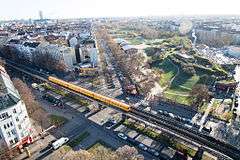 Bird's-eye view of the park | |
  | |
| Type | Urban park |
| Location | Kreuzberg, Berlin |
| Coordinates | 52°29′47″N 13°26′16″E |
| Area | 14 hectares (35 acres) |
| Created | 1980s |
| Status | Open year-round |
History
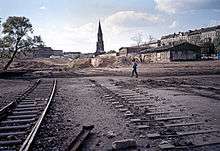
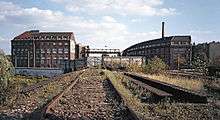
The original Görlitzer Bahnhof (named after the Saxon town of Görlitz) suffered heavy damage during the Battle of Berlin. The last passenger train services to operate through the station ended on April 29, 1951. Demolition of the site took place on 24 October 1962, at the behest of former Berlin Senator, Rolf Schwedler (SPD), despite protests by many residents.
In the postwar period, the site was used as a coal depot. Until 1985, freight trains still operated through the Görlitzer Bahnhof train lines, supplying nearby storage sheds and a junkyard on the station grounds. During the division of Berlin, a border crossing was erected on the bridge over the Landwehr canal to control the passage of these freight trains. The remains of this border crossing are still visible today, as are a short piece of track to the east of the canal bridge and two former freight sheds still remain from the former station.
Görlitzer Park is widely known as a hotspot for purchasing cannabis.[4][5]
Park conception
In the early 1980s, a civil and squatter movement began pushing for the creation of a "Görlitzer City Park" on the site of the old Bahnhof. In the spring of 1983, a program of "greening" of the area was scheduled:
"The northern part of the area, from Görlitzer Ufer along Görlitzer Straße to the Fatih Mosque, could at least provisionally be greened. ‘For the development of vegetation, a design hasn't been agreed upon. [...] That's why the citizens do not need to get involved.' (Parks Department) "
— - Südost Express: Wunder dauern etwas länger (Miracles take a little longer), 7-8 / 1982
At this time, the soil at the site of a former scrap metal compactor was heavily contaminated with oil and needed to be replaced, and an area of the future park was still being used as a coal depot. However, the Reichsbahn management proved to be supportive of the park plans and "Cheerfully developed a children's petting zoo on the southern track. Material and feed donations from surrounding industries flowed in abundantly, and bulldozers from a local cement plant came by occasionally to donate topsoil. Only the money to lease the land was still lacking.[6]
Final approval from the Environment and Finance Senators was still pending at that time.
Children's playground
According to the Südost Express, "the district office of Kreuzberg had already rented the 4000 square meter site," by 1979, as part of the initiative by Verein SO 36, a local civic group. However, the building authorities wanted to use the site to construct a Spreewald-Bad swimming pool complex. "More than 1000 signatures have been collected so far for this playground. [...] (After negotiations) the district office will seek to find a solution that makes both the building project and a children's playground possible on the Görlitzer Bahnhof site."[7]
The park today
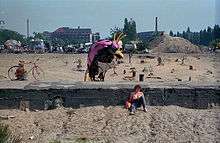
At the end of the 1980s, a district park was built on the former railway site to the plans of the Freie Planungsgruppe Berlin. Today, only remnants of tracks, the pedestrian tunnel, the former enclosure wall, and three freight sheds exist of the former station.
In the south of the present park, several railway bridges connected the station area with the district of Treptow, one of which is still preserved, that leads pedestrians over the Landwehr Canal. A green corridor on the former railway line runs parallel to Kiefholzstraße and deep into Alt-Treptow so that cyclists and pedestrians can access Treptower Park through Görlitzer Park. Until the fall of the Wall, the Berlin Wall ran along the Landwehr Canal. Also, in the southern part of the area, in the corner formed by Görlitzer Ufer and Wiener Straße, a railroad wheelhouse used to exist. Today, there is a hill with a slide and an 80-metre (260 ft) toboggan run. The park borders Wrangelkiez on the north/northeastern side.
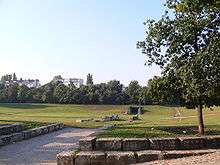
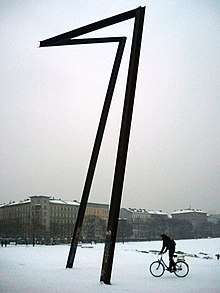
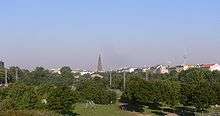
The Görlitzer Tunnel was still walkable until at least the end of 1989, the removal of which gave the park a large hollow in the middle, which forms a kind of natural arena. The former walls of the tunnel were included as a design element and are still recognizable today. On the west side of the basin is a 14-metre (46 ft) steel-beam sculpture, Schreitender Mensch, by Rüdiger Preisler.
Location
The park is bounded to the northwest by Spreewaldplatz, the former station forecourt which now houses the Wellenbad am Spreewaldplatz swimming pool complex. The swimming pool complex was built between 1984 and 1987 according to plans by architect Christoph Langhof. In the north, Lausitzer Platz flanks the area with the Emmaus Church, which was built between 1890 and 1893 according to plans by August Orth. They are separated from the park by the viaduct of the Berlin U-Bahn lines U1 & U3 along Skalitzer Straße. In the south, the area borders the Landwehr Canal and the district of Alt-Treptow.
Former Pamukkale Fountain and Plans for Redesigning the Park

The Pamukkale fountain, created by the sculptor Wigand Witting from 1994 to 1997 and completed in 1998, was one of the main design elements in Görlitzer Park. It was inspired by the travertine terraces of Pamukkale, Turkey and became a special place of remembrance for the many citizens of Kreuzberg with Turkish ancestry. Due to a faulty substructure and lack of drainage for the foundations, as well as problems with the Portuguese limestone used, the construction was so badly damaged by its first winter that it had to be closed to visitors for security reasons. For a long time, there was a dispute over the restoration.[8] In October 2000, the artist was sentenced to pay damages in the amount of 1.1 million euros. This sentence was confirmed again in November 2008.[9][10] In autumn 2009, the crumbled fountain construction was removed along with the sculptures that were still intact at the time. The demolition was not without controversy, and led to demonstrations. Unknown activists poured large amounts of red paint down the terraced landscape as a sign of the bleeding out of a significant work of art for the integration and diversity of Berlin's cultures.
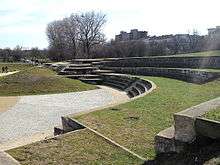
The remaining concrete terraces were laid out with artificial turf and now are used for seating.[11]
After the demolition of the fountain and the dissatisfaction of many park visitors with the condition of the park, the district office of Friedrichshain-Kreuzberg organized an "ideas workshop" in 2009 to beautify the park.[12]
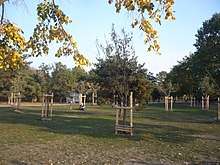
The orchard
Since 2011, in the middle of the park, an orchard with apple, pear and greengage trees was created. In total, there were 26 trees after the third planting in early April 2013.[13] As a memorial to deceased Kreuzberg actor Eralp Uzun, family and friends planted another tree in the meadow in May 2013.
This orchard was created by the Kiezwandlern, a local Transition Town group, with the support of the district's green area office. Committed residents habitually cultivate the orchard meadow.[14] The later harvest from the trees is available to the public.
Drug trafficking
Görlitzer Park is one of the largest drug transfer centers in Berlin. The park has been the site of multiple violent incidents resulting in injuries and even death.[15] The drug dealing originated in parts of the park during the 2000s. Since May 2012, the park area has been subject to constant police patrols.[16] The problems, however, have remained.
In November 2014, the "Task Force Görlitzer Park" was established to curb drug-related crime around Görlitzer Park. This task force consisted of the Berlin Police, the public prosecutor's office, the administration of justice, the immigration office, and the Friedrichshain-Kreuzberg district office.[17] The task force effected several changes to Görlitzer Park, such as removing hedges and shrubs that could serve as drug stashes, as well as greatly increasing the police presence.
Interior Senator Frank Henkel introduced a zero tolerance rule in March 2015 which enabled the police to prosecute consumers and dealers for small amounts of drugs. However, this did not eliminate the drug problem, instead causing many drug dealers to move to other streets, parks and neighborhoods.[18] On October 16, 2017, the Red-Red-Green Coalition rescinded the rule, and the purchase, transportation, and consumption of up to 15 grams (1⁄2 oz) of cannabis in Görlitzer Park has resumed with relative impunity.[19]
References
- "Görlitzer Park". Berlin.de. Retrieved 24 May 2015.
- Ternieden, Hendrik; Roth, Anna-Lena (September 12, 2013). "Drugs in Berlin: Greens Push Weed Legalization in Park". Spiegel Online. Retrieved 24 May 2015.
- Paterson, Tony (7 December 2014). "Kreuzberg: Berlin's hip district becomes a battleground between dealers and gentrification". The Independent. Retrieved 24 May 2015.
- "How to buy weed in Berlin". Retrieved 2017-09-15.
- Popp, Maximilian (2013-03-30). "ASYL: Endstation Görli". Der Spiegel. 14. Retrieved 2017-09-15.
- "Görlitzer Stadtpark rückt näher". Südost Express – die Kreuzberger Lokalzeitung von Bürgern aus SO 36. August 1982.
- "Kinderspielplatz auf dem Görlitzer Bahnhofsgelände". Südost-Express. December 1979.
- "Die lange Dürre von Pamukkale" (in German). Retrieved 2018-10-18.
- "Erneut Aufschub für den Pamukkale-Brunnen" (in German). Retrieved 2018-10-18.
- "Brunnen-Künstler soll zahlen" (in German). Retrieved 2018-10-18.
- "Öffentliche Brunnen in Berlin / Senatsverwaltung für Stadtentwicklung und Umwelt - Berlin". 2014-10-06. Retrieved 2018-10-22.
- "Wayback Machine". 2013-03-05. Retrieved 2018-10-22.
- "Kreuzberg wird "Essbarer Bezirk"" (in German). Retrieved 2018-10-22.
- "Obstbäume im Görli". www.xn--obstbume-im-grli-znb64a.de (in German). Retrieved 2018-10-22.
- Kopietz, Andreas (7 May 2015). "Schwerverletzter nach Attacke in Görlitzer Park: Dealer verletzt 20-Jährigen mit Machete" [Serious injuries following attack in Görlitzer Park: Dealer insures 20-year-old man with a machete]. Berliner Zeitung (in German). Retrieved 2018-10-23.
- "Frank Henkel: Beantwortung einer Kleinen Anfrage über "Ergebnisse der Razzien im Görlitzer Park"" (PDF). 23 December 2013. Retrieved 24 August 2018.
- "Görlitzer Park wird zur Sonderzone | rbb Rundfunk Berlin-Brandenburg". archive.is. 2 December 2014. Retrieved 23 October 2018.
- Germany, Stuttgarter Nachrichten, Stuttgart. "Berliner Brennpunkt Görlitzer Park: Der Drogenpark der Nation". stuttgarter-nachrichten.de (in German). Retrieved 2018-10-23.
- "Im Görlitzer Park darf wieder gekifft werden" (in German). 9 November 2017. Retrieved 23 October 2018.
External links
